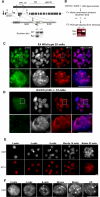CAF-1 is essential for heterochromatin organization in pluripotent embryonic cells
- PMID: 17083276
- PMCID: PMC1630711
- DOI: 10.1371/journal.pgen.0020181
CAF-1 is essential for heterochromatin organization in pluripotent embryonic cells
Abstract
During mammalian development, chromatin dynamics and epigenetic marking are important for genome reprogramming. Recent data suggest an important role for the chromatin assembly machinery in this process. To analyze the role of chromatin assembly factor 1 (CAF-1) during pre-implantation development, we generated a mouse line carrying a targeted mutation in the gene encoding its large subunit, p150CAF-1. Loss of p150CAF-1 in homozygous mutants leads to developmental arrest at the 16-cell stage. Absence of p150CAF-1 in these embryos results in severe alterations in the nuclear organization of constitutive heterochromatin. We provide evidence that in wild-type embryos, heterochromatin domains are extensively reorganized between the two-cell and blastocyst stages. In p150CAF-1 mutant 16-cell stage embryos, the altered organization of heterochromatin displays similarities to the structure of heterochromatin in two- to four-cell stage wild-type embryos, suggesting that CAF-1 is required for the maturation of heterochromatin during preimplantation development. In embryonic stem cells, depletion of p150CAF-1 using RNA interference results in the mislocalization, loss of clustering, and decondensation of pericentric heterochromatin domains. Furthermore, loss of CAF-1 in these cells results in the alteration of epigenetic histone methylation marks at the level of pericentric heterochromatin. These alterations of heterochromatin are not found in p150CAF-1-depleted mouse embryonic fibroblasts, which are cells that are already lineage committed, suggesting that CAF-1 is specifically required for heterochromatin organization in pluripotent embryonic cells. Our findings underline the role of the chromatin assembly machinery in controlling the spatial organization and epigenetic marking of the genome in early embryos and embryonic stem cells.
Conflict of interest statement
Competing interests. The authors have declared that no competing interests exist.
Figures







References
-
- Surani MA. Reprogramming of genome function through epigenetic inheritance. Nature. 2001;414:122–128. - PubMed
-
- Rideout WM, III, Eggan K, Jaenisch R. Nuclear cloning and epigenetic reprogramming of the genome. Science. 2001;293:1093–1098. - PubMed
-
- Morgan HD, Santos F, Green K, Dean W, Reik W. Epigenetic reprogramming in mammals. Hum Mol Genet. 2005;14:R47–R58. - PubMed
-
- Okamoto I, Otte AP, Allis CD, Reinberg D, Heard E. Epigenetic dynamics of imprinted X inactivation during early mouse development. Science. 2004;303:644–649. - PubMed
-
- Li E. Chromatin modification and epigenetic reprogramming in mammalian development. Nat Rev Genet. 2002;3:662–673. - PubMed
Publication types
MeSH terms
Substances
LinkOut - more resources
Full Text Sources
Other Literature Sources
Molecular Biology Databases

